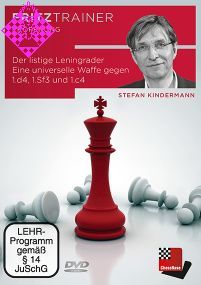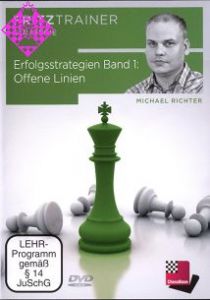Artikelnummer
SCOKINDLL
Autor
Der listige Leningrader
Eine universelle Waffe gegen 1.d4, 1.Sf3 und 1.c4
ChessBase, 1. Auflage 2016
Aus der Reihe »Fritz Trainer Opening«
Die Leningrader Variante der Holländischen Partie (nach 1.d4 f5 nebst Sf6 und g6) wirft dem Weißen schon im ersten Zug den Fehdehandschuh hin und macht klar, dass es ein Spiel auf „drei Resultate” geben wird. In jüngster Zeit wird diese scharfe Eröffnung auch von Spielern der absoluten Weltelite wie Hikaru Nakamura, Fabiano Caruana, Ruslan Ponomariow oder Gata Kamsky wieder mit großem Erfolg eingesetzt. Stefan Kindermann gilt als einer der größten Experten des „Leningraders” und stellt mit dieser DVD ein kompaktes Repertoire vor, das dem neuesten Stand der Theorie entspricht. Als Bonusmaterial liegen der DVD ausführliche PGNDateien bei.
Struktur:
1. Historie und grundlegende Zugfolgen - zum Umgang mit dieser DVD
2. Typische Pläne und Motive aus schwarzer Sicht - das will Schwarz erreichen
3. Typische Pläne und Motive aus weißer Sicht - dagegen muss Schwarz sich wappnen
4. Konkrete Theorie - die kritischen Zugfolgen
5. Testpositionen - sind Sie fit für den Leningrader?
Trainings-Videos: 4 Std. 24 Min. (Deutsch)
Interaktiver Abschlusstest mit Video-Feedback
Extra: 50 Modellpartien und 2 Praxisbeispiele vom Autor, ausführliche Analysedatenbank
Mit CB 12 - Reader
Stefan Kindermann ist Internationaler Schachgroßmeister und Mitbegründer sowie Geschäftsführer der Münchener Schachakademie. Er hat an acht Schacholympiaden und einer Weltmeisterschaft teilgenommen, ist Trainer sowie Autor mehrerer Fachbücher. Zudem ist er Psychologischer Berater und Coach und hat gemeinsam mit Prof. Robert von Weizsäcker das Strategiemodell Königsplan entwickelt das er in Form von Vorträgen,Seminaren und Beratungen an Führungskräfte vermittelt.
SYSTEMVORAUSSETZUNGEN:
Mindestens:
·Pentium III 1 GHz, 1 GB RAM
·Windows Vista, XP (Service Pack 3) ®
·PC Intel Core i7, 2.8 GHz, 4 GB RAM
Struktur:
1. Historie und grundlegende Zugfolgen - zum Umgang mit dieser DVD
2. Typische Pläne und Motive aus schwarzer Sicht - das will Schwarz erreichen
3. Typische Pläne und Motive aus weißer Sicht - dagegen muss Schwarz sich wappnen
4. Konkrete Theorie - die kritischen Zugfolgen
5. Testpositionen - sind Sie fit für den Leningrader?
Trainings-Videos: 4 Std. 24 Min. (Deutsch)
Interaktiver Abschlusstest mit Video-Feedback
Extra: 50 Modellpartien und 2 Praxisbeispiele vom Autor, ausführliche Analysedatenbank
Mit CB 12 - Reader
Stefan Kindermann ist Internationaler Schachgroßmeister und Mitbegründer sowie Geschäftsführer der Münchener Schachakademie. Er hat an acht Schacholympiaden und einer Weltmeisterschaft teilgenommen, ist Trainer sowie Autor mehrerer Fachbücher. Zudem ist er Psychologischer Berater und Coach und hat gemeinsam mit Prof. Robert von Weizsäcker das Strategiemodell Königsplan entwickelt das er in Form von Vorträgen,Seminaren und Beratungen an Führungskräfte vermittelt.
SYSTEMVORAUSSETZUNGEN:
Mindestens:
·Pentium III 1 GHz, 1 GB RAM
·Windows Vista, XP (Service Pack 3) ®
·DirectX9 Grafikkarte mit 256 MB RAM
·DVD-ROM Laufwerk
·Windows Media Player 9
·und Internetverbindung zur Programmaktivierung.
Empfohlen: ·PC Intel Core i7, 2.8 GHz, 4 GB RAM
·Windows 7 oder Windows 8 ®
·DirectX10 Grafikkarte (oder kompatibel) mit 512 MB RAM oder mehr
·100% DirectX10 kompatible Soundkarte
·Windows Media Player 11
·DVD-ROM Laufwerk
·und Internetverbindung zur Programmaktivierung
| EAN | 9783866815605 |
|---|---|
| Gewicht | 100 g |
| Hersteller | ChessBase |
| Breite | 13,5 cm |
| Höhe | 19 cm |
| Medium | Download, DVD |
| Erscheinungsjahr | 2016 |
| Autor | Stefan Kindermann |
| Reihe | Fritz Trainer Opening |
| Sprache | Deutsch |
| Auflage | 1 |
| Name | ChessBase GmbH |
|---|---|
| Adresse | Osterbekstr. 90 a Hamburg 22083 Deutschland |
| Internet | www.chessbase.de |
| info@chessbase.de |
Einführung [03:03]
Holländisch Leningrader Variante
Datenbanken: Theorie; Praxisbeispiele Kindermann; Weißmotive; Schwarzmotive; Testaufgaben; Modellpartien
01: Leningrader Zugfolgen Teil 1: 1.d4 f5 2.e4/Sc3/Lg5 - Notation [06:54]
02: Leningrader Zugfolgen Teil 2: 1.d4 f5 2.g3 Sf6 3.Lg2 g6/e6 - Notation [04:54]
03: Leningrader Zugfolgen Teil 3: 1.d4 f5 2.g3 Sf6 3.Lg2 g6 4.Sf3 Lg7 5.0-0 0-0 6.c4/b3/b4 - Notation [05:14]
04: Zum Umgang mit dieser DVD [03:56]
05: Schwarzmotive 1 - Barczay,L - Videki,S [04:04]
06: Schwarzmotive 2 - Tataev,M - Kramnik,V [03:02]
07: Schwarzmotive 3 - Spok - Stormbringer-Kindermann [02:57]
08: Schwarzmotive 4 - Beliavsky,A - Kindermann,S [06:43]
09: Schwarzmotive 5 - Anastasian,A - Malaniuk,V [02:43]
10: Schwarzmotive 6 - Spassky,B - Santo Roman,M [02:42]
11: Schwarzmotive 7 - Tukmakov - Malaniuk [03:10]
12: Schwarzmotive 8 - Beliavsky,A - Malaniuk,V [02:39]
13: Schwarzmotive 9 - Pelletier,Y - Onischuk,A [02:21]
14: Schwarzmotive 10 - Gurevich,M - Mainka,R [02:11]
15: Schwarzmotive 11 - Lukacs,P - Szabolcsi,J [02:42]
16: Schwarzmotive 12 - Rogozenko,D - McDonald,N [03:31]
17: Schwarzmotive 13 - Ippolito,D - Zhang,Z [02:25]
18: Weißmotive 1 - Smejkal,J - Danner,G [02:56]
19: Weißmotive 2 - Dreev,A - Malaniuk,V [02:26]
20: Weißmotive 3 - Kramnik,V - Illescas Cordoba,M [02:28]
21: Weißmotive 4 - Doering,T - Kindermann,S [02:17]
22: Weißmotive 5 - Dreev,A - Malaniuk 2,V [02:00]
23: Weißmotive 6 - Antunes,A - Vyzmanavin,A [02:03]
24: Weißmotive 7 - Ribli,Z - Henley,R [02:33]
25: Weißmotive 8 - Horvath,C - Kindermann,S [03:04]
26: Weißmotive 9 - Nakamura,H - Barron,M [03:05]
Theorieteil
27: 1.d4 f5 2.g3 Sf6 3.Lg2 g6 4.Sf3 Lg7 5.0-0 0-0 6.c4 d6 7.Sc3 c6 8.d5 e5 9.Db3/e4 - Notation [05:42]
28: 1.d4 f5 2.g3 Sf6 3.Lg2 g6 4.Sf3 Lg7 5.0-0 0-0 6.c4 d6 7.Sc3 c6 8.d5 e5 9.dxe6 Lxe6 10.b3 - Notation [08:13]
29: 1.d4 f5 2.g3 Sf6 3.Lg2 g6 4.Sf3 Lg7 5.0-0 0-0 6.c4 d6 7.Sc3 c6 8.d5 e5 9.dxe6 Lxe6 10.Dd3 - Notation [06:10]
30: 1.d4 f5 2.g3 Sf6 3.Lg2 g6 4.Sf3 Lg7 5.0-0 0-0 6.c4 d6 7.Sc3 c6 8.Te1 - Notation [06:55]
31: 1.d4 f5 2.g3 Sf6 3.Lg2 g6 4.Sf3 Lg7 5.0-0 0-0 6.c4 d6 7.Sc3 c6 8.Tb1 - Notation [06:46]
32: 1.d4 f5 2.g3 Sf6 3.Lg2 g6 4.Sf3 Lg7 5.0-0 0-0 6.c4 d6 7.Sc3 c6 8.Dc2/b3 - Notation [04:30]
33: b3 Systeme - 1.d4 f5 2.g3 Sf6 3.Lg2 g6 4.Sf3 Lg7 5.0-0 0-0 6.b3 d6 7.Lb2 - Notation [08:20]
34: b4-Systeme - 1.d4 f5 2.g3 Sf6 3.Lg2 g6 4.Sf3 Lg7 5.0-0 0-0 6.b4 - Notation [08:04]
35: c3-Systeme - 1.d4 f5 2.g3 Sf6 3.Lg2 g6 4.c3 Lg7 5.Db3/Sd2 - Notation [07:04]
36: Karlsbader System mit c4 - 1.d4 f5 2.g3 Sf6 3.Lg2 g6 4.Sh3 Lg7 5.Sf4 0-0 6.c4 - Notation [09:05]
37: Karlsbader ohne c4 - 1.d4 f5 2.g3 Sf6 3.Lg2 g6 4.Sh3 Lg7 5.Sf4 Sc6 - Notation [06:38]
38: Zugfolge - 1.d4 f5 2.c4 Sf6 3.Sc3 d6 4.Lg5 Sbd7 5.Dc2 g6 6.0-0-0 Lg7 - Notation [04:35]
39: Stauntongambit 1.d4 f5 2.e4 fxe4 3.Sc3 Sf6 4.f3/g4 - Notation [06:24]
40: Stauntongambit 1.d4 f5 2.e4 fxe4 3.Sc3 Sf6 4.Lg5 - Notation [07:03]
41: 1.d4 f5 2.Sc3 Sf6 3.Lg5 d5 4.f3 - Notation [06:02]
42: 1.d4 f5 2.Sc3 Sf6 3.Lg5 d5 4.e3 - Notation [03:37]
43: 1.d4 f5 2.Sc3 Sf6 3.Lg5 d5 4.Lxf6 exf6 5.e3 - Notation [08:47]
44: 1.d4 f5 2.Lg5 g6 3.Sc3 Lg7 4.e4 - Notation [05:25]
45: 1.d4 f5 2.Lg5 g6 3.Sc3 Lg7 4.h4 - Notation [03:53]
46: Englisch Botwinnik-Variante - 1.c4 f5 2.Sc3 Sf6 3.g3 g6 4.Lg2 Lg7 5.d3 0-0 6.e4 fxe4 7.dxe4 d6 - Notation [05:18]
47: Englisch mit e3 und Sge2 - 1.c4 f5 2.Sc3 Sf6 3.g3 g6 4.Lg2 Lg7 5.d3 0-0 6.e3 d6 7.Sge2 e5 8.0-0 a5 - Notation [04:21]
48: Englisch mit Sf3 - 1.c4 f5 2.Sc3 Sf6 3.g3 g6 4.Lg2 Lg7 5.d3 0-0 6.Sf3 d6 7.0-0 Sc6 - Notation [05:07]
49: 1.Sf3 f5 2.e4 - Notation [03:09]
50: 1.Sf3 f5 2.d3 Sc6 3.e4 - Notation [05:19]
51: 1.Sf3 f5 2.d3 Sc6 3.d4 - Notation [06:39]
Testaufgaben
52: Test 1 [01:57]
53: Test 2 [04:46]
54: Test 3 [02:12]
55: Test 4 [02:52]
56: Test 5 [02:40]
57: Test 6 [02:18]
58: Test 7 [02:08]
59: Test 8 [02:33]
60: Test 9 [03:14]
Holländisch Leningrader Variante
Datenbanken: Theorie; Praxisbeispiele Kindermann; Weißmotive; Schwarzmotive; Testaufgaben; Modellpartien
01: Leningrader Zugfolgen Teil 1: 1.d4 f5 2.e4/Sc3/Lg5 - Notation [06:54]
02: Leningrader Zugfolgen Teil 2: 1.d4 f5 2.g3 Sf6 3.Lg2 g6/e6 - Notation [04:54]
03: Leningrader Zugfolgen Teil 3: 1.d4 f5 2.g3 Sf6 3.Lg2 g6 4.Sf3 Lg7 5.0-0 0-0 6.c4/b3/b4 - Notation [05:14]
04: Zum Umgang mit dieser DVD [03:56]
05: Schwarzmotive 1 - Barczay,L - Videki,S [04:04]
06: Schwarzmotive 2 - Tataev,M - Kramnik,V [03:02]
07: Schwarzmotive 3 - Spok - Stormbringer-Kindermann [02:57]
08: Schwarzmotive 4 - Beliavsky,A - Kindermann,S [06:43]
09: Schwarzmotive 5 - Anastasian,A - Malaniuk,V [02:43]
10: Schwarzmotive 6 - Spassky,B - Santo Roman,M [02:42]
11: Schwarzmotive 7 - Tukmakov - Malaniuk [03:10]
12: Schwarzmotive 8 - Beliavsky,A - Malaniuk,V [02:39]
13: Schwarzmotive 9 - Pelletier,Y - Onischuk,A [02:21]
14: Schwarzmotive 10 - Gurevich,M - Mainka,R [02:11]
15: Schwarzmotive 11 - Lukacs,P - Szabolcsi,J [02:42]
16: Schwarzmotive 12 - Rogozenko,D - McDonald,N [03:31]
17: Schwarzmotive 13 - Ippolito,D - Zhang,Z [02:25]
18: Weißmotive 1 - Smejkal,J - Danner,G [02:56]
19: Weißmotive 2 - Dreev,A - Malaniuk,V [02:26]
20: Weißmotive 3 - Kramnik,V - Illescas Cordoba,M [02:28]
21: Weißmotive 4 - Doering,T - Kindermann,S [02:17]
22: Weißmotive 5 - Dreev,A - Malaniuk 2,V [02:00]
23: Weißmotive 6 - Antunes,A - Vyzmanavin,A [02:03]
24: Weißmotive 7 - Ribli,Z - Henley,R [02:33]
25: Weißmotive 8 - Horvath,C - Kindermann,S [03:04]
26: Weißmotive 9 - Nakamura,H - Barron,M [03:05]
Theorieteil
27: 1.d4 f5 2.g3 Sf6 3.Lg2 g6 4.Sf3 Lg7 5.0-0 0-0 6.c4 d6 7.Sc3 c6 8.d5 e5 9.Db3/e4 - Notation [05:42]
28: 1.d4 f5 2.g3 Sf6 3.Lg2 g6 4.Sf3 Lg7 5.0-0 0-0 6.c4 d6 7.Sc3 c6 8.d5 e5 9.dxe6 Lxe6 10.b3 - Notation [08:13]
29: 1.d4 f5 2.g3 Sf6 3.Lg2 g6 4.Sf3 Lg7 5.0-0 0-0 6.c4 d6 7.Sc3 c6 8.d5 e5 9.dxe6 Lxe6 10.Dd3 - Notation [06:10]
30: 1.d4 f5 2.g3 Sf6 3.Lg2 g6 4.Sf3 Lg7 5.0-0 0-0 6.c4 d6 7.Sc3 c6 8.Te1 - Notation [06:55]
31: 1.d4 f5 2.g3 Sf6 3.Lg2 g6 4.Sf3 Lg7 5.0-0 0-0 6.c4 d6 7.Sc3 c6 8.Tb1 - Notation [06:46]
32: 1.d4 f5 2.g3 Sf6 3.Lg2 g6 4.Sf3 Lg7 5.0-0 0-0 6.c4 d6 7.Sc3 c6 8.Dc2/b3 - Notation [04:30]
33: b3 Systeme - 1.d4 f5 2.g3 Sf6 3.Lg2 g6 4.Sf3 Lg7 5.0-0 0-0 6.b3 d6 7.Lb2 - Notation [08:20]
34: b4-Systeme - 1.d4 f5 2.g3 Sf6 3.Lg2 g6 4.Sf3 Lg7 5.0-0 0-0 6.b4 - Notation [08:04]
35: c3-Systeme - 1.d4 f5 2.g3 Sf6 3.Lg2 g6 4.c3 Lg7 5.Db3/Sd2 - Notation [07:04]
36: Karlsbader System mit c4 - 1.d4 f5 2.g3 Sf6 3.Lg2 g6 4.Sh3 Lg7 5.Sf4 0-0 6.c4 - Notation [09:05]
37: Karlsbader ohne c4 - 1.d4 f5 2.g3 Sf6 3.Lg2 g6 4.Sh3 Lg7 5.Sf4 Sc6 - Notation [06:38]
38: Zugfolge - 1.d4 f5 2.c4 Sf6 3.Sc3 d6 4.Lg5 Sbd7 5.Dc2 g6 6.0-0-0 Lg7 - Notation [04:35]
39: Stauntongambit 1.d4 f5 2.e4 fxe4 3.Sc3 Sf6 4.f3/g4 - Notation [06:24]
40: Stauntongambit 1.d4 f5 2.e4 fxe4 3.Sc3 Sf6 4.Lg5 - Notation [07:03]
41: 1.d4 f5 2.Sc3 Sf6 3.Lg5 d5 4.f3 - Notation [06:02]
42: 1.d4 f5 2.Sc3 Sf6 3.Lg5 d5 4.e3 - Notation [03:37]
43: 1.d4 f5 2.Sc3 Sf6 3.Lg5 d5 4.Lxf6 exf6 5.e3 - Notation [08:47]
44: 1.d4 f5 2.Lg5 g6 3.Sc3 Lg7 4.e4 - Notation [05:25]
45: 1.d4 f5 2.Lg5 g6 3.Sc3 Lg7 4.h4 - Notation [03:53]
46: Englisch Botwinnik-Variante - 1.c4 f5 2.Sc3 Sf6 3.g3 g6 4.Lg2 Lg7 5.d3 0-0 6.e4 fxe4 7.dxe4 d6 - Notation [05:18]
47: Englisch mit e3 und Sge2 - 1.c4 f5 2.Sc3 Sf6 3.g3 g6 4.Lg2 Lg7 5.d3 0-0 6.e3 d6 7.Sge2 e5 8.0-0 a5 - Notation [04:21]
48: Englisch mit Sf3 - 1.c4 f5 2.Sc3 Sf6 3.g3 g6 4.Lg2 Lg7 5.d3 0-0 6.Sf3 d6 7.0-0 Sc6 - Notation [05:07]
49: 1.Sf3 f5 2.e4 - Notation [03:09]
50: 1.Sf3 f5 2.d3 Sc6 3.e4 - Notation [05:19]
51: 1.Sf3 f5 2.d3 Sc6 3.d4 - Notation [06:39]
Testaufgaben
52: Test 1 [01:57]
53: Test 2 [04:46]
54: Test 3 [02:12]
55: Test 4 [02:52]
56: Test 5 [02:40]
57: Test 6 [02:18]
58: Test 7 [02:08]
59: Test 8 [02:33]
60: Test 9 [03:14]
Mehr von ChessBase
-
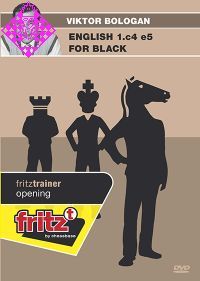 English 1.c4 e5 - for Black!29,90 €
English 1.c4 e5 - for Black!29,90 € -
 Erfolgreich verteidigen34,90 €
Erfolgreich verteidigen34,90 € -
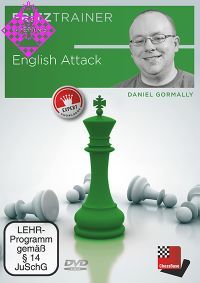 English Attack29,90 €
English Attack29,90 € -
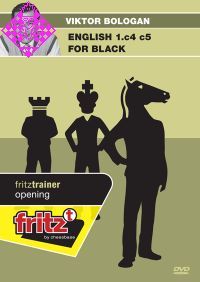 English 1.c4 c5 - for Black!29,90 €
English 1.c4 c5 - for Black!29,90 € -
 Englische Leidenschaft Vol. 229,90 €
Englische Leidenschaft Vol. 229,90 € - Mehr von ChessBase

